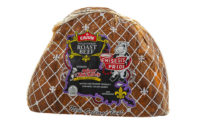
A dash of this or a pinch of that — this is what separates a palatable if bland meal from a tasty, exciting meal that has consumers asking for seconds. A heat-and-eat entree that combines ease of preparation with a flavorful taste becomes a repeat purchase for the consumer. The right combination of seasonings can make a product memorable.
With consumers eating more and more meals at home, they are becoming more adventurous in what they prepare. They are taking their cues from restaurants and meals eaten at other people’s houses to get new seasoning ideas, according to a Mintel 2007 study on seasonings. That trend has been carrying over to retail.
“New product launches reflect an increase in gourmet products ranging from single-ingredient seasonings, led by salt, to innovative herb and spice blends, mainly in the rubs category,” the report says.
One ingredient that has come under increased scrutiny as of late is salt. More and more foodservice operators and food manufacturers are making it a point of offering low-sodium meals or taking salt out of their products.
“We have all known for quite a while that sodium would be on the health agenda for a long time to come,” writes David Lockwood, director of consumer insight for Mintel, in a report entitled Sodium — The Long Haul Is Underway (except it will be fast, rather than long). “But many in the industry took solace in the belief that this problem might take a generation or more to ‘solve.’ Think faster. Much faster.”
Lockwood notes that the 2010 Dietary Guidelines, which is the basis for the USDA’s MyPyramid program, is expected to lower the daily sodium intake to 1,500 mg from 2,300 mg.
The concern about salt may be growing within the government and among consumer watchdogs, but the public in general has yet to jump on the anti-salt bandwagon. Mintel research shows that:
- 34 percent of consumers do not pay attention to sodium
- 26 percent limit the amount of salt they add to food but do not pay attention to salt levels in foods and beverages
- 26 percent read food labels for sodium labels and make some decisions based on that information, but they do not follow a regimen to control sodium in their diet
- 18 percent say “food and beverages low in sodium are one of the three most important components of a healthy diet.”
Flavor savers
Food processors have been using new and different flavors as a way to attract consumer interest to a particular product. Among the top flavors on new products launched within the last calendar year (see sidebar), some of the most popular flavor types were salsa, barbecue, mustard, ranch, garlic, blue cheese, chipotle, raspberry and soy sauce.
When it comes to home preparation, Mintel reports that the seasonings seeing the biggest increase in usage are garlic, cinnamon, oregano, basil and chili. Garlic is used in most world cuisine, accounting for its popularity. Cinnamon is dominant in American cuisine, but also is used in Middle Eastern cuisine. Other seasonings of note that are a part of world cuisine include saffron (Caribbean and Mediterranean), mint and ginger (Asian, Middle Eastern, Cuban) and chili peppers en adobo (Mexican).
“Demand is spilling over from the ethnic communities from which flavors and concepts are derived, into the mainstream population,” Mintel points out. “In turn, increasing exposure through travel and dining out is influencing change in America’s palate. In short, the culinary face of America’s palate is changing.”
Consumers aged 18 to 34 are much more likely to experiment with ethnic flavors, and Mintel notes that these consumers have been introduced to a broad palette of flavors from various sources, including school, restaurants, among friends and at home.
Umami and seasonings
Umami, a Japanese-derived term that loosely translates to “deliciousness,” is considered the fifth taste, along with sweet, salty, sour and bitter. It’s found in high-protein foods, such as meats, seafood, some vegetables and mushrooms, and other foods with the glutamate amino acid.
“There are ways that one can increase the ‘umami-ness’ in cooking,” says Jacqueline Marcus, a food and nutrition consultant whose company, Jacqueline B. Marcus & Associates, is located in Northfield, Ill. “For instance, aging or fermentation increases umami. Soy sauce, teriyaki sauce and fish sauce happen to be high in umami.”
A dish that features several ingredients that are high in umami can create what Marcus calls an “umami synergy,” where the flavor is dramatically intensified.
“If you have an aged piece of meat and put some mushrooms on top of it that were sauteed in truffle butter, that combination would be higher in umami than a younger piece of meat that’s simply grilled without these other ingredients.” Other common dishes that offer an umami synergy include Caesar salad, spaghetti and meatballs with Parmesan cheese, and pizza.
Foods that are high in umami have so much inherent flavor, they do not require as many ingredients to prepare.
“The beauty of working with umami at a meal is that it’s so flavorful, it could potentially require less seasonings and salt,” Marcus says. The more umami a food product has, the less salt it would require.



Report Abusive Comment